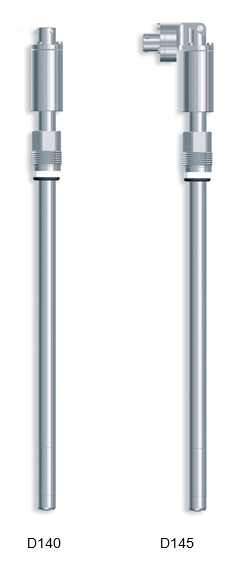D540 and D545 DO Sensors
Models D540 and D545
OxyProbe DO Sensor
After
several years of refinement we are introducing our latest set of improvements
all bundled up in one new sensor, the OxyProbe? II.
The new
membrane design is modeled after our successful 25 mm membrane cartridge. It has
an expandable inner Silicone bladder that holds the electrolyte within a 316L
stainless steel cage. During SIP processes or during autoclaving the electrolyte
turns to steam, but does not distend the measurement membrane because the
internal bladder expands first, taking the pressure off the sensitive
measurement area. This allows us to have a maximum of electrolyte present, with
minimum risk of damage to the sensor. The new membrane cartridge design is easy to use
and durable enough to be used many times over if necessary.
REPLACEMENT PARTS
O-rings: AG-SR15
Membrane Cartridges: Single, Four and 16 piece Cartridge
Kits
Choice
of Industry Standard 4-Pin Connector or VarioPin
Our standard D9 connector
has hermetically sealed gold-plated contacts in a glass insulator that offers
the ultimate in signal isolation and transmission. For customers with installed
VarioPin cable systems we also offer the VP connector as a standard option on
all of our designs.
Hygienic Sensor
Design:
•
Microrganisms cannot adhere to the sensor surface due to the enhanced finish
(N5/Ra15μ in Quality).
• The sensor is fully sterilizable
and autoclavable.
Time-Saving
Maintenance:
•
Membrane body and sensor inner body can be changed out very quickly. A simple
membrane body replacement takes just two minutes and can be made on site by the
user.
• Due to the
modular design, the different sensors have basically the same spare parts. This
minimizes inventory stocking requirements.
Features
Overview:
•
Autoclavable and steam sterilizable.
• Accurate measurement and quick
response.
• Long
lasting and easy to maintain membranes.
• FDA positive listed materials of
construction.
•
Hygienically polished N5 surface finish (Max. Ra15μ in).
• Wetted O-rings comply with FDA and
USP Class VI standards.
Other
Highlights:
• Comes
with either waterproof VarioPin or D9 connector.
• T-Pull connector versions allow
for easy removal from fermenter and reduces strain on cable.
• Variety of sensor lengths
available.
Replaceable Anode/Cathode
Assembly
A concept
pioneered by Broadley-James, this unique assembly permits the sensor to be
repaired quickly and reliably. Send your sensors to us for rebuild and save
about half the price of purchasing a complete new sensor assembly!
D140 and D145 DO Sensors

Models D140
and D145 OxyProbes
The OxyProbe 12 mm dissolved oxygen
sensor offers the most rugged and versatile design for benchtop vessels. The
compact profile saves space on a crowded headplate. It will fit directly into
any 12 mm multipurpose port with standard compression fittings or Pg13.5
threads. The small diameter facilitates DO measurement in small volumes,
especially bottles and spinner flasks.
The OxyProbe 12 mm DO sensor has the
same rugged performance as the 19 mm and 25 mm sensors. This polarographic
sensor utilizes the longer silver anode and small cathode which has become the
industry standard. It also uses the same semi-permeable, Silicon/Teflon
composite membrane, reinforced with stainless steel mesh.
All OxyProbe dissolved oxygen sensors
are available with a right angle connector. This low profile design
provides:
•
Protection against cable fatigue
• Improved grip for sensor
extraction
• Increased
clearance between vessels
• Reduced random sensor mobility on flat
surfaces (won’t roll off the table)
REPLACEMENT PARTS
Membrane Cartridges: Single, Four, and 25 piece Cartridge
Kits
SPECIFICATIONS
Features:
• 316L Stainless Steel
• Serialized for
traceability
• RA32
finish with electropolish on wetted parts
• Internal EPDM
o-rings
How to choose a
sensor:
(1)
Determine how far the sensor should project into the vessel.
(2) Decide whether a right
angle connector is preferred over a straight connector.
(3) Choose the correct cable
length and connector. All DO sensors require
cable and connector
assemblies.
It is important to regularly
maintain the sensors by inspecting and calibrating them. The membrane cartridge
should be checked and refilled prior to every use.





